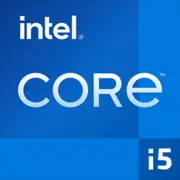Intel Core i5-14600KF

Intel Core i5-14600KF: In-Depth Expertise for Gamers and Professionals
March 2025
Key Specifications: Architecture, Process Technology, and Main Features
The Intel Core i5-14600KF is part of the Raptor Lake Refresh lineup, built on a hybrid architecture comprising Performance-cores (P-cores) and Efficient-cores (E-cores). This is a 14-core chip (6 P-cores + 8 E-cores) with 20 threads, where P-cores provide high performance in gaming and single-threaded tasks, while E-cores optimize multi-threaded workloads and energy efficiency.
Process Technology and Frequencies:
- Intel 7 Technology (10 nm Enhanced SuperFin).
- Base frequency of P-cores: 3.5 GHz, maximum turbo frequency: 5.3 GHz (for 1-2 cores).
- E-cores operate at 2.6–4.0 GHz.
- L3 Cache: 24 MB.
Key Features:
- PCIe 5.0 support (up to 16 lanes for the graphics card + 4 for NVMe).
- Thermal Velocity Boost technology for automatic overclocking at low temperatures.
- Unlocked multiplier (indicated by "K") for overclocking.
- No integrated graphics (indicated by "F").
Performance:
- Geekbench 6: 2794 (Single-Core), 17190 (Multi-Core).
- In gaming (e.g., Cyberpunk 2077 at 1440p Ultra), it shows 90+ FPS paired with an RTX 4070 Ti.
- Rendering in Blender (BMW scene) finishes in 4.2 minutes compared to 4.8 minutes for i5-13600KF.
Compatible Motherboards: Sockets and Chipsets
The processor uses the LGA 1700 socket, allowing it to be installed on motherboards with 600 and 700 series chipsets:
- Z790 — for overclocking (supports RAM and CPU overclocking, PCIe 5.0 x16 + x4). Example: ASUS ROG Strix Z790-E Gaming ($400).
- B760 — optimal choice for most users: RAM overclocking, PCIe 5.0 for GPU, but no CPU overclocking. Example: MSI B760 Tomahawk WiFi ($180).
- H770/H610 — budget options with limitations (H610 does not support PCIe 5.0 and memory overclocking).
Recommendations:
- For overclocking, choose boards with reliable VRM (e.g., Gigabyte Z790 AORUS Elite AX).
- If you don’t plan to upgrade to PCIe 5.0 SSDs, you can save on models with PCIe 4.0.
Memory Support: DDR4 vs DDR5
The i5-14600KF supports both standards, but the choice depends on the chipset:
- DDR4-3200 (up to 128 GB): budget option. A 32 GB kit (2x16) Corsair Vengeance LPX — $70.
- DDR5-5600 (up to 128 GB): better performance in high-bandwidth tasks (rendering, archiving). A 32 GB kit G.Skill Trident Z5 — $120.
Tip:
- Gamers with GPUs like RTX 4070 and below can suffice with DDR4.
- For 4K video work or ML algorithms, choose DDR5.
Power Supply Units: Power Calculations and Recommendations
With a TDP of 125 W and peak power up to 180 W (when overclocked), the PSU requirements are:
- Minimum: 650 W (for systems with a GPU up to RTX 4070).
- Recommended: 750–850 W (for RTX 4080/4090 or overclocking).
Examples:
- Corsair RM750x (80+ Gold, modular) — $120.
- Be Quiet! Straight Power 11 850W Platinum — $170.
Important:
- Use PCIe 5.0 12VHPWR cables for modern GPUs.
- Avoid cheap noname power supplies — voltage spikes can damage the CPU.
Pros and Cons of the i5-14600KF
Pros:
- Best price/performance ratio in the $300–350 segment.
- High overclocking potential (up to 5.6 GHz on P-cores with adequate cooling).
- Support for both DDR4 and DDR5 — flexibility in building.
Cons:
- High heat output under load (up to 95°C in stress tests).
- Requires expensive liquid cooling or top-tier air coolers.
- Lack of iGPU — unsuitable for backup systems.
Use Case Scenarios: Who is the Processor Suitable For?
1. Gaming: Ideal for 1440p and 4K when paired with a GPU at the RTX 4070 Ti level or higher. In CS2 and Fortnite, it provides a stable 240+ FPS.
2. Work Tasks:
- Video editing in DaVinci Resolve: rendering a 10-minute 4K clip takes 12 minutes.
- Programming: compiling large projects on 20 threads.
3. Streaming: NVENC + 8 E-cores offload CPU during streaming in OBS.
Limitations: Not recommended for servers or 24/7 render farms due to heat output.
Comparison with Competitors: AMD vs Intel
- AMD Ryzen 7 7700X ($300): 8 Zen 4 cores, 5.4 GHz.
- Pros: Energy efficiency (105 W TDP), built-in GPU.
- Cons: Fails to match in multi-thread tasks (Geekbench Multi-Core: 16300).
- AMD Ryzen 5 7600X ($250): 6 cores. Cheaper, but 30% weaker in multi-threading.
Conclusion: The i5-14600KF outperforms AMD in gaming and heavy workloads but falls short in power consumption.
Practical Assembly Tips
1. Cooling:
- Minimum: DeepCool AK620 ($65).
- For overclocking: Arctic Liquid Freezer II 360 ($130).
2. Case: Choose models with good ventilation (Lian Li Lancool III or Fractal Design Meshify 2).
3. RAM: For DDR5, choose modules with low timings (CL36 or lower).
4. Additionally: Don’t skimp on thermal paste (Thermal Grizzly Kryonaut — $15).
Final Verdict: Who Should Buy the i5-14600KF?
This processor is an optimal choice for:
- Gamers, seeking maximum FPS without overpaying for i7/i9.
- Content creators (editing, 3D) needing multi-threaded performance.
- Enthusiasts, experimenting with overclocking.
Price: $320 (new, March 2025).
Alternative: If you need integrated graphics or less heat output, consider the Ryzen 7 7700X.
If you are building a PC "for years" and are ready to invest in cooling, the i5-14600KF will be a reliable foundation for your system. It may be overkill for office tasks or HTPC setups, but will unleash its full potential in gaming and work builds.
Basic
CPU Specifications
Memory Specifications
GPU Specifications
Benchmarks
Compared to Other CPU
Related CPU Comparisons
Share in social media
Or Link To Us
<a href="https://cputronic.com/index.php/cpu/intel-core-i5-14600kf" target="_blank">Intel Core i5-14600KF</a>

